| Article ID | Journal | Published Year | Pages | File Type |
|---|---|---|---|---|
| 8396906 | Toxicon | 2013 | 7 Pages |
Abstract
Saxitoxin and its derivatives, the paralytic shellfish toxins (PSTs), are known to be toxic to humans, and maximum permitted levels in seafood have been established by regulatory authorities in many countries. Until recently, the mouse bioassay was the reference method for determining the levels of these toxins in seafood, but this has now been superseded by chemical methods of analysis. The latter methods are able to determine the levels of many PSTs in shellfish, but for risk assessment an estimate of the relative toxicities of the individual components of the PST mixture is required. The relative toxicities are expressed as “Toxicity Equivalence Factors” (TEFs). At present, TEFs are based on relative specific activities in the mouse bioassay, rather than on acute toxicity determinations, as measured by median lethal doses (LD50s). In the present study, the median lethal doses of saxitoxin, neosaxitoxin, decarbamoyl saxitoxin and equilibrium mixtures of gonyautoxins 1&4 and gonyautoxins 2&3 have been determined by intraperitoneal injection, gavage and feeding. The results indicate that specific activities in the MBA do not consistently correlate with acute toxicities by any of the routes of administration, and TEFs, particularly for neosaxitoxin, require revision.
Related Topics
Life Sciences
Biochemistry, Genetics and Molecular Biology
Biochemistry, Genetics and Molecular Biology (General)
Authors
Rex Munday, Krista Thomas, Ryan Gibbs, Cory Murphy, Michael A. Quilliam,
